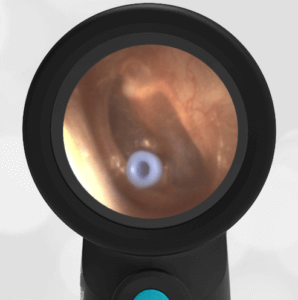
Tympanostomy Tubes
A 7-year male patient is brought into the emergency department by his mother. The mother explains that the child has a history of ear infections and recently had “ear tubes” placed. She is concerned because the child says his ears “feel funny.” Otherwise, the child has no complaints. The mother would like the child “checked-out” because of his history of ear infections. Examination of his ears with the Wispr Digital Otoscope reveal these images.
The images show tympanostomy tubes (ear tubes).
Both tubes (the blue circles) are well-placed and appear patent. The ears are otherwise normal. The eardrum is not bulging, there is no erythema (redness) and the bony landmarks are normal. On close inspection, you can see exquisite vasculature associated with the malleus. This is a normal finding.

Left Ear – Tympanostomy Tube
Pressure in the middle ear is regulated by the eustachian tube that connects the oral cavity to the middle ear. Adults are accustomed to equalizing the pressure in their ear (for example on an airplane in descent) by increasing pressure in their mouth. In children, the developing anatomy of the eustachian tube may not be straight enough to accommodate the relief of pressure in the middle ear. This can lead to recurrent infections and discomfort. Ear tubes, sometimes called ventilation tubes, are placed to help with this condition until their anatomy matures. The tubes relieve the pressure in the middle ear by communicating directly with the “outside.” The tubes typically fall out on their own over the course of months to a year. There will often be evidence of prior tympanostomy tubes.
At Wispr University, you will find an article on normal ear anatomy.


























































































































































































